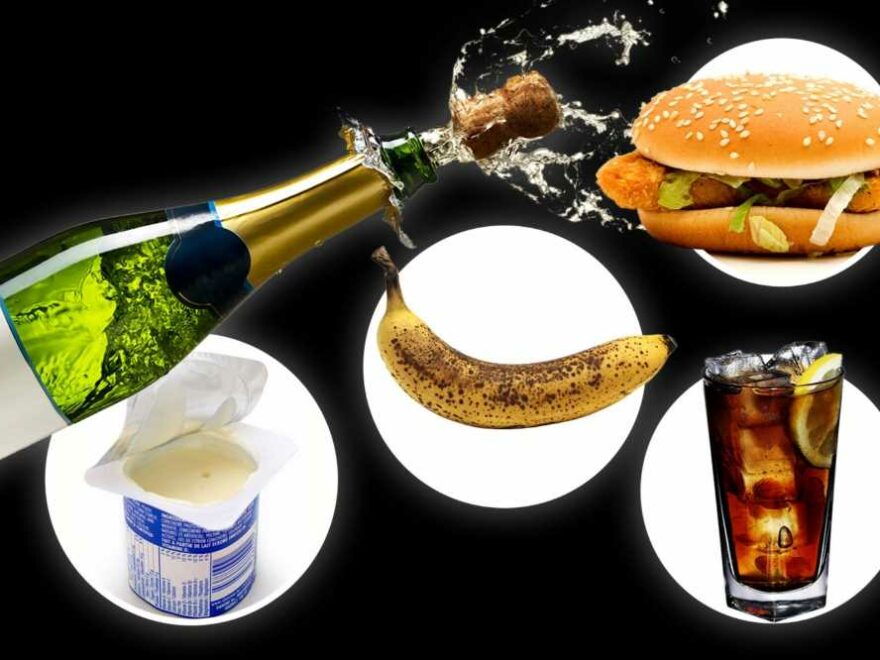WHEN you think of alcoholic foods, your mind might go to a boozy trifle.
But did you know there are traces of alcohol lurking in foods you have on a daily basis?
If you have yoghurt or juice for breakfast, you're probably consuming some alcohol without knowing.
And you can even find it in some common fruit – not enough to get you drunk of course.
The amount of alcohol in everyday foods and drinks tends to fluctuate and how much of it is generated depends on how long they're left to ferment, said Peter Szczepanski, clinical lead in alcohol and substance sisuse for rehab centre Abbeycare.
This is measured in alcohol by volume (ABV).
Read more on booze
From liquorice to DIY acupuncture – 14 hangover cures that actually work
I’m a dentist – all the ways gin and Prosecco are ruining your looks
Here are some foods and drinks, which you might not have realised pack a punch.
1. Bananas
A ripe banana has about 0.2 per cent ABV – but that's double in a very ripe banana, which has 0.4 per cent.
2. Bread
According to registered dietitian Dr Duane Mellor from Aston University, bread that uses yeast for leavening will have alcohol in varying degrees.
He told the Mail that while bread proves, the yeast in it will ferment the carbohydrates and produce alcohol.
Most read in Health
First British baby with THREE parents born in 'groundbreaking leap for IVF'
Is your phone addiction making you sick? Here are the 8 signs to watch out for
Warning to millions on antidepressants for chronic pain as 'drugs don't work
I looked like swollen toad until £9.50 'secret weapon' turned my life around
Peter wrote that burger rolls and rye bread contain between 1.18 and 1.28 per cent ABV.
For reference, low alcohol beers sold in the UK don't contain more than 1.2 per cent ABV, according to Drinkaware.
3. Fruit juices
The levels in grape, orange and apples juices will increase the longer you leave it in your fridge without drinking them and they tend to yield about 0.04 to 0.5 per cent ABV.
"Certain groups, especially children, may be affected by the consumption of large volumes of fruit juices," Peter wrote.
4. Yoghurt and Kefir
According to Dr Mellor, any fermented foods are likely to contain traces of alcohol.
Common breakfast foods like yogurt and kefir contain alcohol due to the microorganisms that feed off the milk's natural sugar, lactose, Peter said.
But these bacteria are actually good for your gut, he added.
5. Kombucha
The fizzy, vinegary drink is yet another fermented product touted for its gut boosting properties.
The fermented tea contains about 0.5 per cent ABV.
6. Vinegar
Vinegars will often pass through the alcohol fermentation process to get to the final product, so will contain varying levels of it.
This includes sherry, white wine, champagne and apple cider vinegar.
7. Soft drinks
Some fizzy drinks contain alcohol, most likely due to their high sugar content, Peter said – this can be up to 0.5 per cent ABV.
But he added that manufacturers also use ethanol as a carrier for volatile and natural flavouring materials, which may increase alcohol levels in these beverages.
8. Condiments and additives
Condiments like mustard and soy sauce can have between 1.5 and 2 per cent ABV.
Extracts or flavourings that you might use in baking – such as vanilla extract can actually contain pretty high concentrations of alcohol – up to 35 per cent ABV.
But Peter said cooking or baking times – as well as the amount of extract used – will affect the overall alcohol content remaining in your baked good.
However, it appears that manufacturers also use ethanol as a carrier for volatile and natural flavouring materials, which may increase alcohol levels in these beverages, he noted.
Avoiding foods that contain alcohol will place less stress on your digestive system, Peter said.
Read More on The Sun
I found my dream council home on Facebook – I did all the work myself
I’m a travel expert – here’s why you should always get on a plane LAST
He also claimed it would increased the nutrition and diversity of your diet.
But he noted that to do so, you'd need to be pretty diligent at reading food labels when you're doing your food shop and you might also find it harder to eat at restaurants.
Source: Read Full Article









